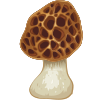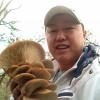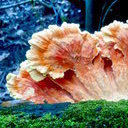-
Posts
119 -
Joined
-
Last visited
Profile Information
-
Gender
Male
-
Location
Toronto, Canada
Recent Profile Visitors
3,825 profile views
theplanets's Achievements

Morchella Senior Member (3/5)
-

Found lots of new (to me) mushrooms this weekend
theplanets replied to jdcooper's topic in General Mushroom Discussion
Last one looks too thin and small to be Coprinospis atramentaria, IMO. -
I'd be too afraid to eat these. Too much of a newbie to make that attempt.
-
I second that opinion!
-
Nice photos JD! And welcome to the forum!
-
Could also be this. Gloeophyllum sepiarium (Fries) Karsten COMMON NAME: Yellow-red Gill Polypore. CAP: 14" (2.510 cm) wide, semicircular to kidney-shaped, flat or slightly convex, stalkless, fibrous-tough; surface covered with short stiff hairs, becoming matted and felty or nearly smooth in age, with distinct concentric zones and furrows, bright yellowish red to reddish brown; margin whitish to orange-yellow or brownish yellow, uneven, with tufts of tiny hairs. FLESH: up to ¼" (6 mm) thick, fibrous-tough, yellow-brown to rusty brown, black in KOH. PORE SURFACE: golden brown to rusty brown, gill-like to labyrinthine (often both), and sometimes with elongated pores; pores 12 per mm. SPORE PRINT: white. MICROSCOPIC FEATURES: spores 913 x 35 µm, cylindric, smooth, hyaline. FRUITING: solitary, in groups, or rosette-like clusters on decaying wood, usually conifer; year-round; common. EDIBILITY: Inedible. COMMENTS: Lenzites betulina (inedible) has white flesh and usually grows on decaying hardwood. Gloeophyllum trabeum (inedible) has crowded gills and narrow pores, up to 4 per mm along the margin.
-
Try this for size. Phaeolus schweinitzii (Polyporaceae) Dyers Polypore Grows solitary or grouped on roots of or under conifers Cap 11 cm wide, circular to fan shaped, multi-capped, broad cushion shape to shallow depressed in age, wooly matted fibers on surface when young, smoother as it ages, orange to brownish yellow or greenish yellow at margin when actively growing, rusty brown to dark brown when old, sometimes concentrically zoned Pore surface Decurrent, mustard yellow to greenish yellow, 1 to 3 pores per mm or joined to form larger pores near stalk, turns brown to black in age, tubes 2 to 10 mm long Flesh Yellowish to rusty brown, often appearing zoned Stalk (If present) 1 to 6 cm by 1 to 5 cm thick, often tapers downward, sometimes appearing to root, central to off-center, texture like cap Spore print White to yellowish-green Spores 5-9 x 3-5 microns, elliptical, entire Comments: This uncommon species is difficult to identify as it goes through many color and shape changes as it develops and ages. It has only been recorded at Toft Point in August and September. - See more at: http://www.uwgb.edu/biodiversity/resources/mushrooms/descriptionsP-Z.asp
-
I've found H. ulmaris with off centre stalks. Hon-shimeji is much smaller, and grows in clusters. Can't be 100% without further analysis.
-
This looks like the Hypsizgus ulmaris that I find around here. Mature specimens' cap usually does not flare out like oysters.
-

New to site - first non-intro post with pictures:
theplanets replied to chef's topic in General Mushroom Discussion
Yes. As DaveW suggests, they look very different from the Chickens I'm used to. That's why I asked. Your picture looks like there a stem and cap growing on ground? All very different from the usual Laetiporus. -

New to site - first non-intro post with pictures:
theplanets replied to chef's topic in General Mushroom Discussion
Looks delish! What are baby chicks? -

Random Photos I've Taken HQ (updated info and new photos)
theplanets replied to maverickmarc's topic in Identifying Mushrooms
I would suggest you label them with numbers for easier identification by others. -
Looks like Pholiota squarrosa or Pholiota squarrosoides. From mushroomexpert: "Theoretically, Pholiota squarrosoides can be separated from the very similar Pholiota squarrosa without the use of a microscope, since its gills go from whitish to rusty brown without passing through a greenish stage, and its cap is often slightly sticky underneath the scales (as opposed to the always-dry cap of Pholiota squarrosa). Additionally, Pholiota squarrosoides never develops the garlicky odor that some collections of Pholiota squarrosa develop." http://www.mushroomexpert.com/pholiota_squarrosa.html http://www.mushroomexpert.com/pholiota_squarrosoides.html
-

Crimson (Hygrocybe Punicea) HQ Photos
theplanets replied to maverickmarc's topic in Identifying Mushrooms
Beautiful mushroom! I'd love to see your pictures Maverick. -

Hello everyone, my name is Michael...
theplanets replied to MichaelJerryMitchell's topic in Introductions
Welcome to the forum Michael! Which medicinal mushroom are you taking daily and in what way? -
Hard to tell from the unfocused and off-colour photos for the last 2, but they could be older dried specimens of Ganoderma lucidum or tsugae. The last photo looks like it has pine/hemlock needles on the left most specimen, which could possibly indicate G. tsugae. Better photos needed.




